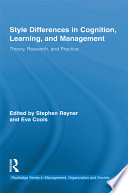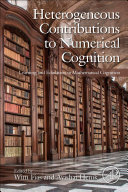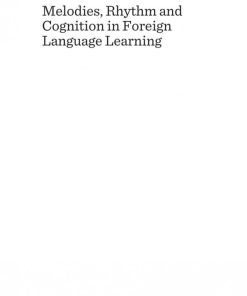Style Differences in Cognition Learning and Management 1st Edition by Stephen Rayner 9781136901638 1136901639
$50.00 Original price was: $50.00.$25.00Current price is: $25.00.
Style Differences in Cognition Learning and Management 1st Edition by Stephen Rayner – Ebook PDF Instant Download/Delivery: 9781136901638, 1136901639
Full download Style Differences in Cognition Learning and Management 1st Edition after payment

Product details:
• ISBN 10:1136901639
• ISBN 13:9781136901638
• Author:Stephen Rayner
Style Differences in Cognition, Learning, and Management
Theory, Research, and Practice
This book aims to mark fifteen years of contributions to the field of style research in cognition and learning presented at the annual conference of the European Learning Styles Information Network. The style field is a multidisciplinary, global community made up of researchers in several domains of knowledge including education, psychology, business, computer science, information systems, management, human resources and other related fields. The book will be relevant for readers who are interested in differences in thinking and learning, covering a wide range of style-related themes with appeal to readers seeking an international and interdisciplinary perspective. Interested practitioners will include professionals working in the areas of HR Management, Organizational Learning, Business Management and all phases of Education. The application of style differences, for example, impacts widely upon work and human performance in areas of policy-making, team-management and project development (sports, social agency, and medicine). New or alternative research paradigms facilitating revision and consensus in the field of style differences are presented. The aim of integrating research and practice is developed to achieve consensual theory for style differences in human performance. Style Differences in Performance is a timely and field-defining volume that will change the way academics and practitioners across international and disciplinary boundaries think and talk about the field of learning style and its implications for human achievement.
Style Differences in Cognition Learning and Management 1st Table of contents:
1 Setting the Scene The Journey toward a Paradigm Shift
Introduction: Setting the Scene
Part I The Theory of Style Differences
Part II Personal Diversity: Individual Differences in Thinking, Learning, and Knowledge Acquisition
Part III Personal Diversity: Differences in Lifelong Learning and Workplace Contexts
Part IV: Summing Up: The Journey Continues …
Bibliography
Appendix 1A Overview of Chapters in the Book
Part 1 The Theory of Style Differences
2 Determining Cognitive Styles Historical Perspective and Directions for Future Research
Introduction
Historical Perspective on the Development of the Cognitive Style Construct
First Period: Origins of Cognitive Style Research
Second Period: The Proof of the Concept of Cognitive Style
Third Period: Cognitive Styles in the Wider Context of Applied Fields
Fourth Period: Recent Trends in Cognitive Style Research
Determining Cognitive Style and Direction for Future Research
Bibliography
3 Basic Psychometrics for Model Building and the Validation of Cognitive Style
Introduction
Psychometrics: Measuring and Explaining Style?
Classical Test Theory
Psychometrics, Epistemological Conflicts, and Gobbledygook?
Statistical Modeling
An Outline of Key Statistical Routines
Correlation
Multiple Regression: Moderation and Mediation
Factor Analysis
Spatial Modeling
Modeling Structure: Structural Equation Modeling (SEM)
Psychometric Validity
A More Coherent Approach
Theoretical Validity
Invalidity
Meaning
Consequential Validity
Conclusion
Bibliography
4 The Theory of Mental Self-Government Grows Up Where Has It Led the Field after 21 Years?
Introduction
The Theory of Mental Self-Government and its Research Tools
Main Research Findings
Styles as Traits versus States
Styles as Value-Laden Versus Value-Free
Styles as Different Constructs versus Similar Constructs with Different Style Labels
From the Theory of Mental Self-Government to the Threefold Model of Intellectual Styles
The Threefold Model: Further Contributions
Contributions to the Field of Intellectual Styles
Practical Significance for Education and Beyond
Conclusions
Bibliography
5 The Learning Flexibility Index Assessing Contextual Flexibility in Learning Style
Introduction
Previous ELT Research on Learning Flexibility
Construct Validation of the LFI
Demographic Variables
Learning Style
Integrative Development
Method
Samples
Measures
Results
Using the LFI for Personal Development
Conclusion and Implications
Bibliography
6 Further Understanding Learning in Higher Education A Systematic Review on Longitudinal Research Using Vermunt’s Learning Pattern Model
Introduction
Theoretical Framework
Learning Patterns
The Inventory of Learning Styles
Similarities and Differences with Approaches to Learning
Theoretical Stance on Change and Stability in Learning Patterns
Research Aim: Empirical Evidence from Longitudinal Studies
Method
Criteria for Inclusion and Search Procedures
Synthesizing the Studies
Results
Change and Stability
Relationship with Personal and Contextual Factors
Gaps and Future Directions
Bibliography
Part 2 Personal Diversity Style Differences in Thinking, Learning, and Knowledge Acquisition
7 Assessing the Distribution of Learning and Adaptive Styles in an MBA Program
Introduction
Students Learn in Different Ways
Consequences of Graduate Students’ Diverse Approaches to Learning
Hypotheses
Method
Sample
Measures
Results
Discussion
Bibliography
8 Kolb’s Learning Styles and Approaches to Learning through the Use of Students’ Critical Questions
Introduction
Theoretical Foundations
Student-Generated Questions
Approaches to Criticality
Questioning in a Critical Context
Kolb’s Learning Styles
Methodology
Procedure
Participants
Strategies to Foster Student-Generated Questions
Data Gathering and Analysis
Instruments for Encouraging and Collecting Student-Generated Questions
Learning Styles Inventory
Interviews
Research Findings and Discussion
Kolb’s Learning Styles and Students’ Questions
Discussion of Findings
Conclusions, Implications, and Recommendations
Bibliography
9 Relating Knowledge Structures to Learning Styles and University Teaching
Introduction
Knowledge Structures
Linking Knowledge Structures and Learning Styles
Concept Mapping and Teaching
Activating Prior Knowledge
Linearity in Teaching
Personal Teaching Models
Knowledge Structures—A Sociological Perspective
The Structure of the Discipline
In Conclusion
Bibliography
10 Illustrating a Complementary Paradigm for Styles Research From a Third-Person to a Second-Person Perspective
Introduction
Comparing the Two Paradigms
The Theoretical Framework of the Second-Person Perspective
Illustrating the Second-Person Perspective
Study 1: Understanding the Effects of the PD
Study 2: Understanding Teacher Responses to Constructivist Learning Contexts
Study 3: Understanding Teachers with Extremely Strong Style Preferences
Study 4: Evaluating the PD Intervention Quantitatively
Conclusions
Suggestions for Further Research
Understanding the Relationship Between Teachers’ Sensitivity to Styles Preferences and Their Students’ Success
Increasing Learner Effectiveness with the second-Person Perspective
Understanding the Impact of Strength-of-Style Preference
Determining When Styles Are Important to Address
Sustaining Constructivist Learning Contexts
Broadening the Target Groups for Styles Research
Bibliography
Appendix 10A Summary of the Style Concepts used in the Professional Development in the Four Studies
Learning Style Inventory (LSI; Kolb, 1976)
Learning Combination Inventory (LCI; Johnston & Dainton, 1997)
Left/Right Hemisphere Preferences Inventory (Torrance, 1980)
Visual/Auditory/Kinesthetic Modalities Inventory (VAK; Barsch, 1980)
Group Embedded Figures Test (GEFT; Witkin et al., 1971)
4-MAT Model (McCarthy, 1980)
Triarchic Abilities Model (Sternberg, 1985)
11 Teaching Secondary Teachers about Style Should We Do It?
Introduction
So What are Styles?
Why are Styles Argued to be Important for Educational Success?
Academic Success
Style Matching and Academic Success
Style and Nonacademic Success
An Empirical Study: Introducing Style to Secondary Teachers
Appreciating Differences
Questioning the Veracity of Styles as a Construct
Personal Change
Study Limitations and Caveats
Conclusion
Notes
Bibliography
12 Patterns in Student Learning and Teacher Learning Similarities and Differences
Introduction
Patterns in Student Learning
Teaching to Foster Student Learning and to Enhance Students’ Capacity to Learn
New Teachers’ Roles and Skills
Patterns in Teacher Learning
Teachers’ Learning Activities
Towards Teachers’ Learning Patterns
Conclusions and Prospects
Conclusions about Student and Teacher Learning Patterns
Prospects for Future Research on Student and Teacher Learning Patterns
Bibliography
13 Enhancing Feedback Practice A Personal Learning Styles Pedagogy Approach
Introduction
Feedback: Could Do Better?
Employing a Personal Learning Styles Pedagogy to Inform Feedback Practices
Methodology
Findings
Analysis and Intuition Style Dimensions
Variations in Student Perceptions of Feedback: Consensus and Difference
Practical Implications
Assessment Design and Clarity
Ensuring Student Involvement in the Process
Encouraging Self-Regulation within Learners
Future Directions for Research
Bibliography
Part 3 Personal Diversity Style Differences in Lifelong Learning and Workplace Contexts
14 Learning Styles and Personal Pedagogy in the Virtual Worlds of Learning
Introduction
Defining Learning Style and Context Sensitivity
Characterizing Learning Styles and Culture
Personal Learning Styles Pedagogy in Virtual Worlds
A Case for Learning Styles and Personal Pedagogy in Second Life
Second Life Scenario: Exploring Learning Styles and Personalized Learning in Virtual Worlds
Concluding Comments: Styles and Personalization in Virtual Worlds
Acknowledgments
Bibliography
15 Cultures of Learning Cultures of Style
Introduction
Learning in Context
Learning Styles
Culture
The Influence of Culture on Learning Styles
The Case of International Higher Education: Methodology
The Case of International Higher Education: Findings
Practical Implications
Implications for Style Research
Bibliography
16 Personalizing Web Environments on Cognitive Style The Effect on Users’ Performance
Introduction
Theoretical Background
Method
E-Learning Experiment
Personalization Rules for the Educational Environment
Commercial Web Site Experiment
Personalization Rules for the Commercial Environment
Results
E-Learning Experiment
Commercial Web site
Discussion
Bibliography
17 Improving Business Education for the 21st Century The Role of Cognitive Styles
Introduction
Cognitive Style: A Brief Review
Balancing Styles
Emphasis on Analytic Processing
Case Studies
Journaling
Mind Mapping
Alternative Evaluation Methods
Improvement of Analytic Processing
Shifting Styles
Collaboration
Where We Go From Here
Online Learning
Simulations
Conclusion
Bibliography
18 Learning-Styles-Based Differentiating Instruction for At-Risk Students Rationale, Research Documentation, Assessment Tools, and Alternative Approaches
Introduction
Critical Perspectives on Learning Styles
Eight Challenges Educators Face in the US
Why Differentiating Through Learning Styles is Recommended for Instructional Improvement
A Proposal for the USE of Learning Style Diagnostic Tools
Response to Failure: A Failed Response
Creating a Culture of Success
Identifying Learning Styles: Instruments, Interpretations, Bases for Differentiation
What is Common among All These Learning Style Instruments?
What is Unique About Each Assessment?
Implications for At-Risk Students
How to Apply Learning Styles Theory to Educational Practice: Differentiating Instruction Based on Learning Style Strengths
Conclusion: How will Educators Cope when there are no more At-Risk Learners?
Bibliography
19 Putting Style Theory into Practice in the UK Secondary School Inclusive Classrooms for Vulnerable Learners
Introduction: Style Theory, Inclusion, and the Challenge of the Secondary School
The Impact of Style Theory Upon Teaching and Learning
Style and the Learner: Using Better-Fit Pedagogy to Develop Independent Learners
Practical Approaches: Establishing Frameworks for Learning
Utilizing Preferred Learning Modes or Cognitive Style
From Style Theory to Practice
Style Preference—The Cognitive Toolkit
Further Cognitive Tools: Mind’s Eye or Mind’s Ear?
Using the Mind’s Ear: Verbal Strategies and Support
Developing Strategic Thinking and Metacognition in Classroom Learning
Adapting Pedagogy and Classrooms to Facilitate Access—Inclusive Practices
Conclusion
Bibliography
Part 4 Summing Up The Journey Continues …
20 Researching Style More of the Same or Moving Forward?
Introduction
Theoretical and Conceptual Evolutions
Methodological and Measurement Evolutions
What Picture Do We Get From the Style Field at this Moment?
Where Do We Want to Go from Here?
Applications of Styles
Note
Bibliography
Contributors
Index
People also search for Style Differences in Cognition Learning and Management 1st:
style differences in cognition learning
different cognitive styles
cognitive learning styles examples
cognitive differences examples
types of learning in cognitivism
You may also like…
Business & Economics - Management & Leadership
Politics & Philosophy
Engineering - Robotics & Artificial Intelligence
Deep Learning for Robot Perception and Cognition 1st Edition Alexandros Iosifidis (Editor)
Uncategorized
Politics & Philosophy - Ancient & Medieval Philosophy
Politics & Philosophy - Government & Politics
Uncategorized
Cognition and Language Learning 1st Edition by Sadia Belkhir ISBN 9781527546608 1527546608











